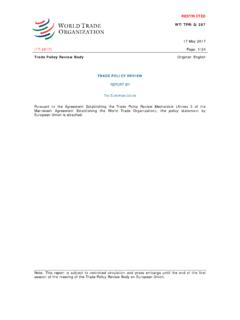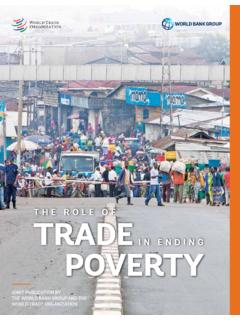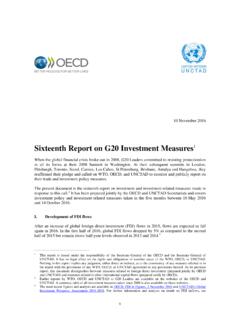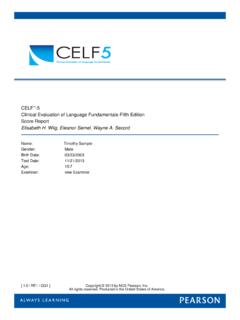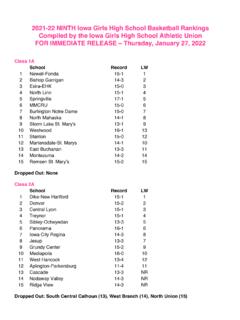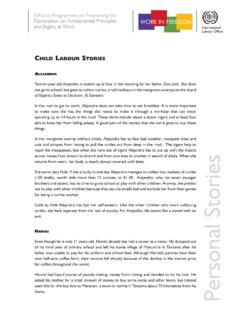Transcription of COVID-19 AND AGRICULTURE: A STORY OF RESILIENCE
1 26 August 2020 Page: 1/12 Original: English 1 COVID-19 AND agriculture : A STORY OF RESILIENCE INFORMATION NOTE1 Key points The COVID-19 outbreak and its rapid spread caught many governments and agricultural producers by surprise, prompting immediate policy responses by WTO members. Many of the initial measures were expected to impact negatively on the agricultural sector. But agriculture has in fact shown RESILIENCE , with a trade performance that has fared better than other sectors. The initial response measures were aimed at addressing members most urgent concerns: containing the virus to save lives, and ensuring food security at home. In addition to lockdowns, these measures included policies that both facilitated and restricted agriculture trade: new sanitary and phytosanitary (SPS) measures and tariff reductions, as well as export restrictions.
2 There was also an increase in stockpiling. Agricultural trade flows changed significantly, due notably to a sudden change in consumption patterns triggered by the measures put in place. Initial measures focused on guaranteeing the immediate availability of food, have been followed by a second phase of policies seeking to mend broken supply chains and to help agricultural producers to cope with the new normal situation. While many governments have gradually relaxed lockdown measures, removed several export restrictions, and introduced domestic support measures to support the agricultural sector, the pandemic continues to spread in different parts of the world and is expected to continue to influence the demand for and supply of agricultural products. Trade in agricultural products has been more resilient than overall trade. This reflects the essential nature of food and the resulting relative income-inelasticity of demand for it, as well as the fact that most agricultural trade (notably cereals and oilseeds) takes place in bulk marine shipments that have not been subject to major disruptions.
3 While overall merchandise trade fell sharply in the first half of 2020, agricultural and food exports increased by per cent during the first quarter of the year compared to the same period in 2019, with an increase of per cent in March, followed by a per cent increase in April, although the preliminary data for May indicate a small decrease ( per cent) compared to This overall picture conceals the fact that demand for certain agricultural products ( non-food agricultural products such raw fur skins, wool or flowers) dropped dramatically, while increasing for others ( , staple food, processed fruits and vegetables) reflecting initial panic buying and increased home-based consumption. In April 2020, exports dropped also for several food products, notably for higher-value products, such as fresh produce, dairy and meat, which are generally more dependent on sales to restaurants, schools and the tourism sector than to households.
4 In addition, high-value perishable products transported by air were hit harder by the sudden collapse in air passenger traffic, which diminished air freight capacity and raised costs. Impacts have varied across regions. Asia saw its agricultural exports decline in March 2020, followed by Europe and North America in April. But some regions have seen exports increase compared to the same period in 2019, with the biggest increases in South America, driven by Asian demand for the region s exports of products such as soybeans, sugar and meat. 1 This document has been prepared under the WTO Secretariat's own responsibility and is without prejudice to the positions of WTO members or to their rights and obligations under the WTO. 2 Data for May 2020 were available for a limited set of 64 countries at the time of writing. 2 Food prices were already on a downward trend at the beginning of 2020.
5 The COVID-19 crisis exerted further downward pressure on prices, and therefore on producer revenues. Although June saw the first increase in world food prices since the beginning of 2020,3 prices are expected to remain at low levels amid the economic downturn. While world food stocks and production levels for the most widely consumed staples rice, wheat and maize are at or near all-time highs,4 and lower prices in principle make food more affordable, the COVID-19 pandemic s impact on jobs and incomes has increased the number of hungry people. According to the World Food Programme s most recent estimates, 270 million people could be acutely food-insecure by the end of 2020, representing an 82 per cent increase from before the pandemic. Producing and storing enough food is not sufficient if it does not reach those in need. By contributing to the availability and affordability of food, trade remains a crucial part of the solution to countries food security concerns particularly at a moment when people s incomes are under pressure.
6 It is therefore critical to keep trade flows open, and to ensure that food supply chains stay operational. 1. TRENDS IN AGRICULTURAL MARKETS AND TRADE Trade in food and agricultural products has been more resilient than trade in other Trade in agricultural products (Agreement on agriculture (AoA) definition,6 value terms) even increased in March and April 2020 (by per cent and per cent, respectively) compared to the same period in 2019 (see Figure 1).7,8 Trade in agricultural products has been more resilient than trade in other products owing to several factors including, in particular, the relative income inelasticity of demand for food (given that food products are essential for survival) and the fact that most agricultural trade (notably cereals and oilseeds) takes place in bulk marine shipments that require less human interaction and have not been heavily disrupted by pandemic-related transport restrictions.
7 While total exports increased for many food products, other products saw their exports decrease, with the sharpest drop in exports for non-edible agricultural products (such as raw fur skins, wool, raw hides and skins, vegetable textile fibres, essential oils, live trees and other plants, and flowers). The agricultural products that registered increased exports in March included cereals, some meat products, edible nuts, oilseeds and oleaginous fruits, and fruits (fresh and dried). In April, however, exports of agricultural products dropped for most product groups with the notable exception of oil seeds and oleaginous fruits. The preliminary data for May 20209 seem to confirm the same trend, recording lower levels than in April 2019, with the exception again being oil seeds and oleaginous fruits. The initial increase in exports for many food products, notably in March 2020, reflects in large part the rise in demand for retail products, representing the shift in consumption patterns away from restaurants and other public eateries and towards people s homes.
8 In addition to initial panic-buying by consumers, many governments have revived or increased stockpiling programmes (increasing demand notably for cereals) or have stepped in to procure unsold produce for distribution to populations in need. In April, total agricultural exports remained at a similar level to that of the previous year; however, exports of several individual product groups decreased as a result of reduced demand triggered by lockdown measures. The food products for which trade performance has suffered the most since the outbreak of COVID-19 are those that are most sensitive to transportation disturbances (particularly those requiring airfreight and containers) and/or those for which demand has fallen as a result of confinement measures and the economic crisis (such as high-value perishable products). Cotton is monitored closely at the WTO, given its importance to some of the poorest countries in the world.
9 Cotton exports have dropped significantly since the beginning of the year due to declining 3 According to the FAO Food Price Index. 4 FAO, World Food Situation. 5 Trade statistics in this note are based on available data for countries, representing around 90 per cent of world trade. 6 The Agreement defines in its Annex 1 agricultural products by reference to the Harmonized System of product classification. The definition covers both basic and processed agricultural products, as well as products such as wines, spirits and tobacco, fibres such as cotton, wool and silk, and raw animal skins destined for leather production. Fish and fish products are not included, nor are forestry products. 7 All figures can be found at the end of this information note. 8 Trade in non-agricultural products dropped by per cent in March and by cent in April 2020 compared to the same time period in 2019.
10 See also WTO trade forecast (22 June 2020). 9 Data for May 2020 were available for a limited set of 64 countries at the time of writing. 3 global consumption amid the impact of COVID-19 on global apparel trade. Projections by the International Cotton Advisory Committee (ICAC) show that the global demand for cotton is likely to decrease by 13 per cent in the 2019-20 marketing season compared to the previous season, reducing world cotton exports to million tonnes. According to ICAC, some four million smallholder farmers in Africa are likely to be severely hit by these downward trends, in particular in least-developed countries (LDCs), including the Cotton-4 countries (Benin, Burkina Faso, Chad and Mali), where revenue from cotton accounts for between 8 and 12 per cent of their GDP. Cotton trade represents up to 40 per cent of their total exports revenue, and the sector employs up to 33 per cent of the national work force.




